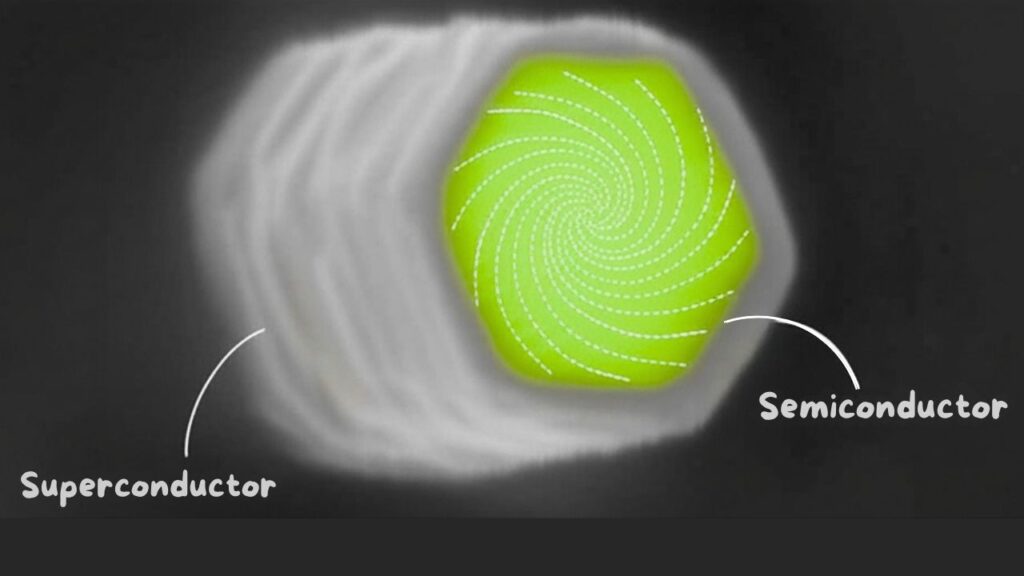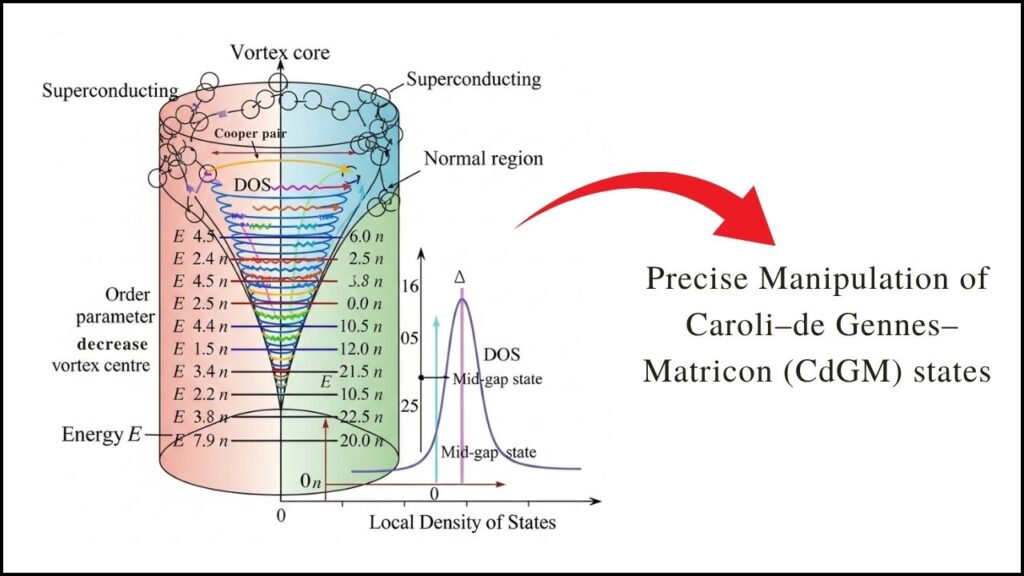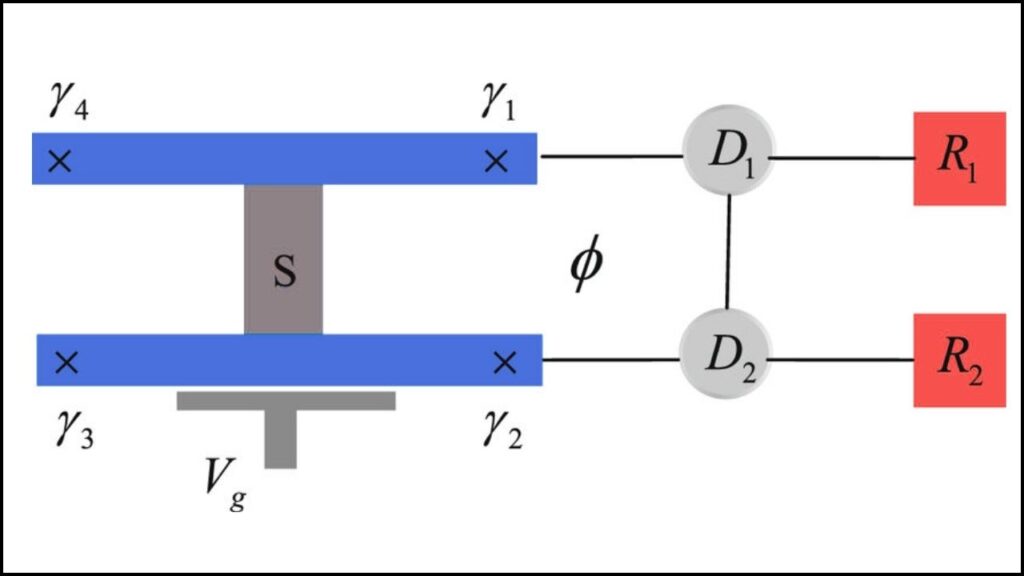Scientists at the Niels Bohr Institute, University of Copenhagen, have achieved a historic breakthrough in quantum physics by solving a puzzle that has persisted for over six decades. Researchers found an ingenious “backdoor” method to access elusive quantum states hidden deep inside superconducting vortices — rare states first predicted in the 1960s but considered almost impossible to study directly.

This surprising discovery is not just a win for theoretical physics; it could open doors to revolutionary advances in quantum computing, ultra-sensitive measurement devices, and next-generation material science. By engineering synthetic systems that recreate the same physical conditions found in natural superconductors, scientists have bypassed the traditional barriers holding back this field.
For the general reader, think of it as finally finding a hidden passageway inside a locked vault — a passageway that scientists have been searching for since your grandparents were young. For professionals, this is about building an experimental platform that allows precise manipulation of Caroli–de Gennes–Matricon (CdGM) states in hybrid quantum materials.

Table of Contents
Quantum Mystery Cracked After 60 Years
| Topic | Details |
|---|---|
| Discovery | Novel “backdoor” to access 60-year-old predicted quantum states |
| Research Institute | Niels Bohr Institute, University of Copenhagen |
| Published In | Physical Review Letters |
| Method | Synthetic superconducting vortices in custom-designed materials with magnetic flux |
| Importance | Enables study of elusive states key for quantum computers, simulators, and new materials |
| Related Quantum Technology Advances | Denmark’s investment in world’s most powerful quantum computer, Magne, set to begin operations in 2026 |
| Career/Professional Info | Opportunities in quantum research at the Niels Bohr Institute and collaborations with leading tech companies |
| Official Reference | Niels Bohr Institute |
The Niels Bohr Institute’s “quantum backdoor” breakthrough is more than just the solution to a six-decade-old physics challenge — it’s a launchpad for the future of quantum technology. By creatively sidestepping the limits of traditional experiments, the researchers have made visible what was once invisible, measurable what was once untouchable.
This development strengthens Denmark’s standing as a leader in quantum science and opens up new opportunities for innovation, collaboration, and career growth in one of the most exciting fields of the 21st century.
Understanding the Quantum Backdoor
To understand the scale of this achievement, we first need to understand the challenge it solves. In superconductors — materials that can carry electricity without energy loss at extremely low temperatures — magnetic fields create tiny whirlpools of current known as superconducting vortices. Inside these vortices lie special quantum states, predicted by theorists Caroli, de Gennes, and Matricon back in the 1960s.
These states are delicate and incredibly fine in their energy structure — so fine, in fact, that they have resisted every serious attempt to measure them directly using conventional techniques. The Copenhagen team overcame this by creating an artificial vortex-like environment that could be carefully tuned and controlled, effectively making it possible to “open the vault” without disturbing what was inside.
Instead of studying these states in natural superconductors where interference is too high, they built synthetic superconducting vortices in hybrid materials combining semiconductors and superconductors. This gave them the freedom to adjust experimental parameters, such as magnetic flux, with remarkable precision — revealing a hidden route into the quantum territory they had been chasing for decades.
Why This Discovery Matters
The implications for modern quantum technology are immense. Here’s why industry experts are taking notice:
1. Advancing Quantum Computing
Quantum computers rely on qubits, fragile quantum bits that can perform calculations beyond the reach of classical computers. Some proposed types of qubits, such as Majorana-based qubits, are closely related to the same physics underlying these rare vortex-bound states.

By understanding and controlling such states, scientists can help stabilize and protect qubits from errors, making large-scale quantum computing more practical.
2. Accelerating Material Science
Synthetic quantum systems like this act as “testbeds” where researchers can mimic and explore extremely complex scenarios. From high-temperature superconductors to novel magnetic compounds, improved access to quantum vortices could help design materials with unprecedented properties — lighter, stronger, more efficient.
3. Enhancing Quantum Sensors
Quantum states are extremely sensitive to environmental changes. Devices based on stable vortex-bound states could be used to detect tiny magnetic fields, gravitational anomalies, or even biological signals with unmatched accuracy.
4. Boosting Regional and Global Research Partnerships
Denmark’s quantum research environment is already among the best in the world. With the upcoming Magne quantum computer and partnerships with global technology powerhouses, this discovery takes the nation’s research capability to an entirely new level.
A Step-by-Step Guide to Understanding the Breakthrough
Step 1: Know the Basics of Superconducting Vortices
Imagine a calm frozen lake with small whirlpools forming here and there — each whirlpool is like a vortex in a superconductor, caused by a magnetic field. Inside these spirals, particles behave differently than anywhere else in the material.
Step 2: The Long-Standing Challenge
The quantum states inside a vortex have energy level separations a million times smaller than the width of a human hair, making them undetectable by direct imaging or spectroscopy in natural conditions.
Step 3: Creating the Artificial Environment
By combining semiconductors and superconductors in carefully patterned nanostructures and threading them with precise magnetic flux, researchers “faked” the conditions of a natural vortex but on their own controlled terms.
Step 4: Achieving the Backdoor Access
This method essentially mimics the inaccessible environment, but in a way that scientists can manipulate freely. The “backdoor” is not a loophole in physics — it’s a clever workaround in engineering.
Step 5: Applications and Next Steps
Moving forward, this approach could lead directly to robust quantum devices, advanced simulations for chemistry and physics, and better understanding of exotic superconductors that could one day operate at room temperature.
Scientists Capture Quantum ‘Eternal Dance’ of Molecules for the First Time Ever
Physicists Discover Planckian Time Limit in Heavy Fermions — A Quantum Tech Leap
Breakthrough: Scientists Unlock Universal Quantum Computing With Exotic Anyons
FAQs About Quantum Mystery Cracked After 60 Years
1. What exactly is a “quantum backdoor”?
It’s an experimental method allowing scientists to study quantum states that are impossible to observe directly by recreating those states in a controlled, artificial setup.
2. Why did it take 60 years to solve this?
The tiny energy differences within these vortex-bound states are beyond the reach of many experimental tools. Only recent advances in nanofabrication and hybrid material design made it possible to create synthetic systems for them.
3. Will this make quantum computers available sooner?
While this discovery is not a direct quantum computer, it addresses a core challenge in making stable and scalable qubits, which could shorten development timelines.
4. What skills are needed to work in this field?
Quantum research combines condensed matter physics, electrical engineering, materials science, and advanced nanofabrication. Skills in cryogenics, quantum measurements, and device design are highly valuable.
5. Is this only important for scientists?
Not at all. In the long run, breakthroughs like this can transform industries from healthcare and finance to energy and cybersecurity by enabling the technologies that power them.



















